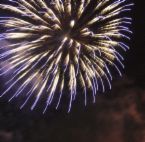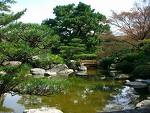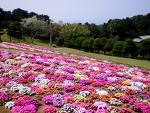Fukuoka
was rated the "16th Most Livable City" and the "Best Retail City" in
the July 2009
Edition of Monocle Magazine
and was selected as one of Newsweek's 10 "Most Dynamic Cities" in its July 2006 Edition
and was selected as one of Newsweek's 10 "Most Dynamic Cities" in its July 2006 Edition
History
and Basic Background of Fukuoka
Because of Fukuoka's proximity to the Asian continent, Fukuoka City has
a nearly 2,000-year history as a trading port. Being the nearest city
to Korea and
China, for a lot of
Japan's earlier history Fukuoka was the city which those entering or
leaving the country passed through . As
such Fukuoka was a gateway to influences from the continent especially
from
China which at that time was one of the world's most advanced
civilizations.
In the Edo Period an ancient golden seal, the "Kin-in" which had been
handed to a local ruler in Fukuoka by the Empereor Guan Wan of the Han
Dynasty, was discovered in Fukuoka and symbolizes the relationship
between Fukuoka and China. From the 7th to 11th centuries, the area
prospered thanks to its essential role as a point of economic and
cultural exchange between Japan and Asia and it is said that Fukuoka is
maybe
the oldest city in Japan. As a successful city and a gateway to
the main continent it attracted the attention of the Mongol Empire
starting in 1268 and from this time Kublai Khan of the Mogol
Empire repeatedly sent envoys to make Japan sucombe to his will,
however, the shogunate resisted and to protect themselves built a stone
wall, 2-3m high and 20km in length bordering the coast of Hakata Bay. You can still see
the remains of the Mogol Wall and
you can see artifacts of the invasions at Genko Historical Museum. In the
invasion launched in 1281 a massive attack was made and Fukuoka
prefecture was overcome by the numbers of Mongolian soldiers and the
walls could not help but as luck would have it the Japanse received aid
in the form of a typhoon which struck a cruching blow to the Mongolian
troops and saved the day. This typhoon is actually the origin of the
famous Japanese word "Kamikaze" and literally means "Divine Wind".Origin of the name of the city of Fukuoka and Fukuoka's emergence as the modern city of today. A powerful daimyo of Chikuzen; Kuroda Nagamasu
Fukuoka first emerged as Kyushu's political, economic, and cultural center in the 1930s. Even though Fukuoka suffered extensive damage during World War II, it recovered and developed into the region's most important city and is now the largest city and metropolitan area west of Osaka. The establishment of national government branch offices, private enterprises, and international organizations has further promoted Fukuoka City's role as the leading administrative city in Kyushu.
Fukuoka's Geography and
Climate
Fukuoka, the home of Samurai
Interpreters, is located in northern Kyushu, the westernmost of
Japan's four major islands. It lies in the center of the Fukuoka Plains
and is surrounded on three sides by mountains, opening into the Genkai
Sea to the north. Fukuoka's climate is comparable to that of the
southern coastal areas of the United States or central and southern
Europe. The annual average temperature is 17C (63 F), annual
precipitation is 1300 mm (50 in), and there is infrequent snow. Fukuoka
is not as seismically active as other areas in Japan, however, it does
experience the occasional earthquake.Places of Interest in Fukuoka
Historical Sights
- Fukuoka
Castle:
 |
Fukuoka
Castle is located in central Fukuoka
between Maizuru Castle
Park and Ohori Park. The decision to build
the castle was made in 1601 by a fuedal lord of Chikusen, Kuroda
Nagamasu who received lands around Fukuoka for his service in battle.
It was
never fully
completed and now all that is left are the remaining ruins, the most
famous of which are Tamon Turret and Otemon Gate which are
about 400 years old, however, in its time Fukuoka Castle was the
largest castle in Kyushu. One cannot complain about the surrounding
beauty. The
castle gardens are
wonderful with the beautiful blooming of the plum blossoms in February
and the blooming of the Sakura (Cherry Blossoms) in March. In the
Cherry Blossom season you will find the grounds full of people
picnicing and barbequeing under the
trees. And to add to this Fukuoka castle provides a breathtaking view
of the city. Having been designated as a Yamanashi Historical Site it
is
definitely worth visiting.
|
Daizaifu
Tenmangu Shrine:
This
is a very
important shrine within the Shinto
faith. The shrine is dedicated to the God of learning; Sugawara no
Michizane and is a major tourist spot in Fukuoka. Not only is it famous
for its historical and religious status, but also simply for the beauty
of the buildings and its grounds, in particular the white plum blossoms
which can be seen from January to April. A recommended Daizaifu
delicacy called Umegaemochi, a sweet plum rice pastry, is a must for
anyone visiting.
|
 |
Uminonakamichi Seaside Park Fukuoka:
Ohori Park: |
 |
 |
Ohori
Park Japanese Garden: This beautiful
Japanese garden is located adjacent to the Fukuoka Art Museum inside Ohori
Park but
is
separated from it by a beautiful white stone wall so you cannot see
into it unless you pay the entrance fee and enter through the wooden
gates to the other side. The garden is a gravel garden in Zen
style and within the garden there is a quaint traditional style
"Sukuya" -styled tea house. It is very pleasant to walk around and
relax in and has many beautiful settings of which you can take you can
take great photos. The garden contains many features which it might be
good to read up on so that you won't miss any of the meanings
associated with them.
Maizuru Castle Park: These are the gounds
surrounding Fukuoka Castle which is about 400 years
old and is a great place for rest and relaxation. Especially during the
Cherry Blossom season it becomes one of the top locations for Cherry
Blossom parties when you will see many people gathered under the Cherry
Blossom trees picnicing and barbequeing and of course drinking but even
during the other seasons it is certainly a pleasurable place to take a
walk and have a coffee.
|
 |
 |
Noko Island:
Noko Island is located just a few kilometres from Hakata
Bay
and is very easy to get to with the frequent and reliable ferry
service. It is a natural park about 150 thousand square meters and
filled with flowers all year round. Rape blossoms and Cosmos are the
most famous for this area. It is certainly a beautiful area with
restaurants, a zoo, mini golf, and Omode-dori which is a reproduced
small old town. If you want to stay longer, which you will, there are
rental cottages and bungalows available.
|
Museums
- Fukuoka Art Museum: This museum can be
found within the ground of Ohori Park. For those of you interested in
art, the collection to be found in Fukuoka Art Museum is definitely
worth having a look. It has a large collection of oriental pre-modern
artworks as well as modern art and contemporary artworks.
- Fukuoka Asian Art Museum: This museum highlights the art works of
Asia. It was opened in 1999 and is the only museum in the world to
collect and exhibit modern and contemporary art from Aisia and thus
allows people to become familiar with Asian arts and culture. It is
located in central Fukuoka in the Riverain Building near
Hakata-za, the Kabuki (Japanese traditional) theatre. So you can
experience two different art forms in close proximity to each other.
- Fukuoka City Museum This museum is located in Momochi close
to Seaside Momochi. It holds an impressive collection of ancient and
modern artifacts from Japan and Asia. The entrance fee is very is very
cheap so it's definitely worth having a look and everyone is free to
use the educational faciites inside such as the information
centre, the Aisan experience room and the reading room.
- Genko Historical Museum: Also known as the Mongolian Invasions
Historical Museum, this museum exhibits historical materials relating
to the Mogolian invasions of northern Kyushu. You can take a look
at the armour of the armies of both Japan and Mongolia at the time and
crtitically compare the technology of both countries. Also on display
are pictures of the Mongolian invasions.
- Hakata Machiya Folk Museum: The old name for Fukuoka when it was in
its historical prime was Hakata and even today the dialect of Fukuoka
is still called Hakata dialect. Here at the Hakata Machiya Folk
Museum you can learn all about Hakata culture. You can leatn about the
old lifestyle and culture of Fukuoka city in the Meiji and Taisho eras
especially about urban living and houses from those times. You can even
have a look at a miniture town of Hakata in it's great days. It is
located across from the Kushida Shrine
which is famous for holding one of the most famous festivals in Fukuoka
City; the Hakata Gion Yamakasa.
There are also lectures held on the Hakata dialecct and
demonstrations of traditional hand crafting are also on exhibition.
- Fukuoka Convention Center: Made up of the Fukuoka International Congress Center, Marine Messe Fukuoka and the Fukuoka Kokusai (International) Center.
- The Fukuoka International Congress Center offers facilities for large scale conventions including the latest simultaneous interpreter booths and audio/visual equipment to respond to the high demands in the information age. Connected by a walkway to the Sun Palace Hotel makes it the perfect convention location.
- Marine Messe Fukuoka is a versatile facility used for many different types of events, functioning as a multi-purpose exhibition facility for large scale events, an arena facility for athletics and a hall facility for concerts.
- Fukuoka Kokusai Center has 5,052 square
meters of flat
floor space with no protruding pillars and serves as a flexible
facility suitable for a variety of activities. The center is home to a
wide variety of uses from large-scale exhibitions to sporting events
and is capable of accommodating up to 10,000 people.
- Shikanoshima Beach
- Itoshima Beach
- Seaside Momochi
Traditional Japanese Theatres
- Hakata-za:Hakata-za is
located in the Hakata Riverain
complex in Nakasu and is a theatre in Fukuoka City
famous for its Kabuki
plays but also has musicals and modern dramas. Being a modern theatre
visablity is very good from all seats. As an art form Kabuki is a truly
wonderful experience with the decorative costumes and energetic
performances.
- Ohori Park Noh Theatre:This theatre is
located in the beautiful Ohori Park just 5 minutes from the centre of
Fukuoka City, Tenjin. There are often free Noh and Kabuki
performances held
here so if your timing's right you might just get a little bit of
Japanese culture for free.
Others Sites of Interest
- Uminonakamichi Marine World:For
those of you who love marine life this is definitely the place to go.
Fukuoka's Uminonakamichi Marine World has beautiful and colorful
aquarium displays including a gigantic water tank with a depth of
7meters holding 1400 gallons of water housing at least 120 sharks of 20
different kinds and there is also an outdoor
dolphin and sea lion show.
- Fukuoka Tower: Fukuoka Tower is located at
the waterfront of Seaside Momochi and it is the tallest seaside tower
in Japan. It was constructed in 1989 and is 234m high and covered with
8000 mirrors. You can take
the elevator up to 123m for a panoramic view of Fukuoka City. At night
the tower lights up which is beautiful to watch. The lighting scheme is
different for each season.
- Sky Dream Fukuoka: Sky Dream Fukuoka is a
ferris wheel located next to Evergreen Marinoa shopping
arcade. It is 120m high and known to be the tallest ferris wheel in
Asia. It takes about 20 minutes to complete one round and offers
wonderful views of the city. It is right next to the harbour and so the
water view is also splendid. At night it lights up and really does look
beautiful by the water.
- Fukuoka Dome: For all you baseball fans
this is a must. Fukuoka Dome is the baseball stadium of Fukuoka and the
headquarters of Fukuoka's baseball team Fukuoka Softbank Hawks. It is
situated in Hawks Town and right next to Seaside
Momochi. It was built in 1993 and can hold 35,695 spectators.
Futhermore it was stadium in Japan to have a retractable roof. Not only
has Fukuoka Dome hosted one game in each Major League Baseball All Star
Series since it opened it has also been used for the music concerts of
famous starts such as the Rolling Stones, Bon Jovi, Queen, Micheal
Jackson and many others. Just opposite Fukuoka Dome is a Hard Rock Cafe
which is a great way to end the day.
- Fukuoka City Zoological Garden / Fukuoka Municipal
Zoo and Botanical Garden: As with most places of interest in
Fukuoka, Fukuoka's Municipal Zoo and Botanical Gardens are located in
the central city area.
The zoo was established in 1953 and has an array of animals to observe
including the ones everyone wants to see such as the lions, tigers and
polar bears. It is a lovely little zoo and doesn't cost an arm and a
leg to enter so people living in the near vicinity may visit as many
times as they like during the year and many keep up with the animals.
This is also true of the
botanical garden which contains about 1300 types of outdoor plants and
about 1,200 species of flower in the greenhouses. Surrounding the
Fukuoka zoo and botanical garden is a expansive park which is great for
walks and getting away from the city while still being in the city.
- Moo Moo Land (Abura-Yama Ranch): This is
a ranch just 30 minutes from the central part of Fukuoka City. Here you
can enjoy the farm life of Fukuoka. It is one of the spots where you
can find domesticated animals such as pigs, sheep, horses and cows. The
ranch is situated on the mountains so while relaxing with nature you
can also enjoy the view below. You can also get ice-cream and fresh
milk from the cows of the area. It's a great day trip for families with
small
childen.
- Abura Mountain (night view): Abura
Mountain again is just 30 minutes away from Fukuoka City centre. It
offers a wondeful night view of Fukuoka. You cannot describe it in
words so you'll just have to go see for yourself. It is a popular spot
for couples young and old to just marvel at the city lights.
Shopping in Fukuoka
- Canal City Hakata:
Canal city is a large shopping complex with shops, restuarants and
cinema. It's theme is water and there are beautiful waterspurt displays
all around the complex. It's beautiful at night.
- Marinoa City: This is a shopping
complex with various outlets with a beautiful ocean view and hosts the
largest ferris wheel in Asia the Sky Dream Fukuoka.
- Hakata Riverrain
- Tenjin
- Nakasu
- Hawks Town
Fukuoka's Baseball Team
Fukuoka's baseball team is called Fukuoka SoftBank Hawks, formerly known as Fukuoka Daiei Hawks. Fukuoka Daiei Hawks won the Pacific League championship in 1999, 2000 and 2003 and also won the Japan Series in 1999 and 2003. Now the Fukuoka SoftBank Hawks although not showing the same level of success as in previous years still retain the reputation of their former glory and are still one of the richest teams in Japan.
Food of Fukuoka
- Hakata Tonkotsu Ramen:
This is a pork based soup with thin noodles.
- Mentaiko
- Motsunabe (beef or pork offal hot pot)
- Mizutaki (chicken broth hotpot)
Fukuoka Festivals
- Hakata Gion Yamakasa: This is an annual
festival held in Fukuoka City from
July 1st to
July 15th by Kushida Shrine. A Yamakasa is a portable shrine used to
carry a deity during a festival. At the climax of the festival there is
a race between local teams starting at 4.59a.m. in which they carry the
Yamakasas and race at full speed for a 5km course departing from
Kushida Shrine. The teams compete to finish this course at the fastest
time. Many people come to watch this event even though the it starts so
early in the morning which means it must be worth seeing.
- Dontaku Port Festival:This is another annual festival in Fukuoka City and takes place on the 3rd an 4th of May every year. The actual name Dontaku comes from the Dutch word Zondag meaning "Sunday" or "Holiday" and the festival originated in 1179 under a different name. Following this the festival underwent a few changes and obstacles such as being banned and being suspended during the second world war before becoming what it is today. People dress up in costumes and parade through the streets along with floats banging shamoji spoons and dancing. The festival boasts some 2 million participants each year.
- Fire Festivals
Fukuoka Business
Visit Samurai Interpreters' web site introducing professional interpreters and translators in the Fukuoka region.